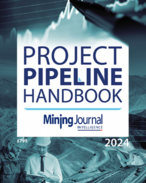This article is 5 years old. Images might not display.
The risk remains top-of-mind for nearly half (44%) of the 150 global mining executive companies polled. EY's report concludes a holistic approach to LTO remains vital, as the sector continues to redefine its image as a sustainable and responsible supplier of the world's minerals, amid rising volatility due to tighter regulations, global trade tensions, and increased pressure from activist investors.
EY's global mining & metals leader Paul Mitchell put the emphasis on LTO down to increased expectations of all mining stakeholders, including investors and consumers.
"In today's climate, increased social pressure could result in a complete loss of licence, so a clear branding strategy is required to address shifting societal expectations. Perceptions of the sector as being old fashioned and dirty need to be challenged, and so building a social bond is make-or-break," he said.
"Miners need to be part of the solution, not the problem, by engaging with topics including the circular economy and green mining of the future."
Now in its 12th iteration, the EY 2020 survey of mining risks as ranked by mining companies also shows ‘future of workforce' rose from seventh to second place in the risk ranking due to increasing demand for and difficulty attracting the digital and data-related skills needed to support the future of mining. This risk category held its position in the top three cited by miners as they grapple with how to unlock the most value from investments.
The eight other risks in the top 10 are digital and data optimisation at three (down one spot), reducing carbon footprint (same as 2019), high impact risks at five (same as 2019), maximising portfolio returns (down from third in 2019), cybersecurity at seven (down from fourth in 2019), replacement of production (same as 2019), innovation at nine and rising costs (down from five in 2019).
Mitchell also pointed out the survey had for a third consecutive year seen significant fluctuations in the risks, as well as new risks coming into the top 10 such as reducing carbon footprint, high impact risks, replacement of production and innovation.
"Every mining and metals company is in the process of defining or executing on their own version of transformation," said Canada mining & metals co-leader Theo Yameogo.
"Digital effectiveness isn't about pushing the boundaries of innovation, which are far more complex to achieve by a single company. It's about raising the visibility and performance of your business by embracing available technologies," he said.
"This transformation requires adequate roadmap and execution plans, which the industry tends to overlook or underestimate."
According to Yameogo, machine learning models and artificial intelligence could surface "incredible insights" for mining and metals players.
"Ultimately, AI uniquely creates or improves a company's competitive advantage by churning multi-source data into valuable business levers. It's a pervasive technology nowadays that the mining and metals sector should start adopting."
Archived article: image not displayed.























